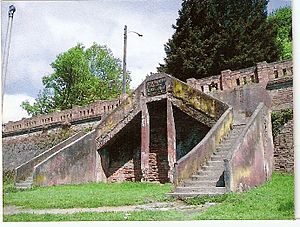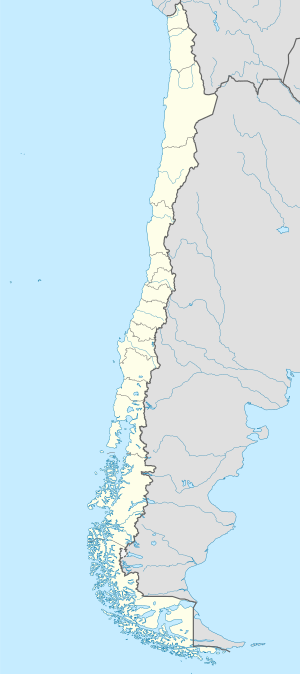Fort Nativity (Fuerte de Nacimiento) facts for kids
Quick facts for kids Fuerte de Nacimiento |
|
|---|---|
| Nacimiento, Bío Bío Chile | |

Fuerte de Nacimiento, viewed from the north-east
|
|
| Coordinates | 37°30′S 72°40′W / 37.500°S 72.667°W |
| Type | Fortress |
| Site information | |
| Condition | partially restored |
| Site history | |
| Built | 1603 1752 (present version) |
The Fort Nativity (Spanish: El Fuerte de Nacimiento) is an old fort in Nacimiento, Chile. It was built on December 24, 1603, by Governor Alonso de Ribera. This fort is about 550 kilometers (350 miles) south of Santiago. It stands on the west side of the Vergara River, right where it meets the Bío Bío. Back then, this area was the southern border of Chile with the Mapuche lands. Most of what you see of the fort today was built in the mid-1700s.
Since 1954, the fort has been a special national monument. It is currently being fixed up after being damaged by an earthquake in 2010.
Why is it called Fort Nativity?
The fort was first called "Fuerte del Nacimiento de Nuestro Señor." This means "Fort of the Nativity of our Lord." This name was chosen because it was founded on Christmas Eve. Over time, people started using the shorter name, "Fuerte de Nacimiento," which means "Fort of Nativity."
The Fort's History
After a big defeat for the Spanish called the Disaster of Curalaba, the King of Spain needed a new governor for Chile. In 1599, he chose a skilled soldier named Alonso de Ribera. Governor de Ribera arrived in Chile in 1600. His main goal was to protect the southern border of the Spanish colony.
Nacimiento was one of several forts built along this border. The spot chosen for the fort was once a Mapuche stronghold. It had amazing views in all directions, which made it hard for enemies to attack by surprise.
In the 1600s, there were more conflicts with the Mapuche people. A Mapuche leader, or Toqui, led an attack on the fort on February 3, 1628. The Spanish captain, Pedro Junco, and his 40 men bravely defended the fort. They held out until more soldiers arrived on February 6. When the attackers finally left, they took some muskets and two cannons.
After this, attacks became more frequent and intense. In 1655, the fort's defenders had to run away. They tried to reach San Rosendo but were killed by the Mapuche. The fort was rebuilt between 1662 and 1665. However, attacks continued, and the fort was later left empty. The Spanish settlers moved their town and defenses to the north bank of the Bío Bío River. It wasn't until 1752 that the fort was moved back to its original (and current) location.
Fort Nativity Today
Today, the Fuerte de Nacimiento is a popular place for tourists to visit. It is surrounded by the town of Nacimiento, which has about 30,000 people. The town mainly focuses on the timber and wood pulp industries.
A big restoration project happened in 2008. There was some debate about whether too many original parts were replaced. Plans to create parks inside the fort walls were never finished.
The fort was badly damaged by a strong earthquake on February 27, 2010. More restoration work is now underway. The fort is also being used more often for cultural and artistic events. This helps it become a bigger part of the daily lives of the town's people.
See also
 In Spanish: Fuerte de Nacimiento para niños
In Spanish: Fuerte de Nacimiento para niños


